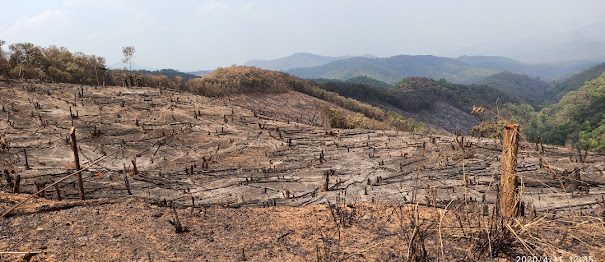CONSERVING FOREST & WILDLIFE: A PRIORITY
Conserving
Forest & Wildlife: A Priority
(With reference to Ukhrul & Kamjong Districts)
R Lester Makang
BRIEF OVERVIEW
Someone has rightly described forests as ‘the lungs of the planet’. This shows the most fundamental function of the forest — it acts as a carbon sink; soaking up carbon dioxide and giving out oxygen to the environment for the survival of human beings and animals.
Forests, simultaneously, provide watershed protection, prevent soil erosion, landslides and mitigate the adverse impacts of climate change or global warming which is driving up the earth temperature due to increase in greenhouse gas emission.
Owing to multiplicity of its functions and characteristics, an all-satisfying single definition of forest seems elusive. To put it simply, forest is ‘a large area of land that grows/shelters diverse species of trees, plants, shrubs, herbs, animals, birds and others.’ And these species dwelling in the forest are known as ‘wildlife’.
Forest sustains life on the planet and its importance cannot be underestimated. Inasmuch as forests provide livelihood for humans, they provide natural habitat for varied species of plants, animals, birds, fungi, bacteria etc. to form a complex community of organisms known as ‘eco-system’.
This ecosystem offers ecological life support to biodiversity by supplying oxygen, clean air, foods and water, pollination of plants, pest control, wastewater treatment and many other ecological services.
It goes without saying that humans also depend on various natural resources and products including food, wood, medicine, fresh water, and the air all living beings breathe. Even then, despite our inextricable dependence on forests for our survival, humans have been directly or indirectly responsible for degradation of land and forest covers at an alarming rate.
It is reported that deforestation due to unbridled human activities, is one primary cause of forest degradation which is manifested in many forms, including wild-fires, clear-cutting for traditional agriculture and other farming activities, clearing of lands for construction or developmental purposes, unsustainable logging for firewood and timber etc.
Deforestation is also said to be subverting the role of forests as carbon sink. As per an estimate, deforestation is responsible for 15 per cent of all greenhouse gas emissions globally.
These unplanned and unnatural changes caused by deforestation, have given rise to myriad factors that limit availability of food, water and shelter/habitat for various indigenous species of animals, birds, insects and organisms.
On the other hand, uncontrolled hunting of wild animals for food and commercial purposes, has led to sudden or gradual decrease in wildlife populations, sometimes even to the extent of extinction.
In this scenario, there has, more than ever, arisen a need for all and sundry to work at all levels of individual, community and government, towards conserving forests and wildlife on a priority basis.
UKHRUL & KAMJONG’S SCENARIO
Myriad forms of deforestation threaten the habitats of different species of animals, birds and other organisms. Sub-tropical rain-forests of Ukhrul and Kamjong districts in Manipur, lost about 3342 sq. km. of forest cover in the last few decades due to human activities.
Naturally, the twin districts are endowed with vast expanses of green covers. Previously, the districts had thick forests covering 3,526 sq. km. which was more than 70 % of their total geographical area of 4,544 sq. km. Out of the 3,526 sq. km. of the forests, very dense forest (VDF), moderately dense forest (MDF) and open forest (OF) constituted 181 sq. km, 980 sq. km and 2,365 sq. km respectively.
However, the entire green covers have now dramatically plummeted to just 184 sq. km. in the face of continued and massive deforestation in the last few decades.
The rain-forests of Ukhrul and Kamjong districts were once well-known for their rich biodiversity. Not long ago, these forests were home to a vast array of indigenous flora and fauna. However, many of these wildlife species have become endangered because of human interferences.
For instance, the unique world-famed Shirui Lily (Lilium mackleanae), which is found only on the peak of Shirui Kashung, some 18 km north of Ukhrul district headquarters, is facing immense threat from indiscriminate feeling of trees, burning of the thick forests and construction of roadway and others.
Major species of timber trees like Teak, Pine, Phoebe (Uningthou), Michelia (Leihao) and others, along with flowering plants like rhododendrons and orchids, found in the forests, are facing a similar fate. Human interference in the nature has largely remained unchecked regardless of various provisions restricting forest exploitations under Forest (Conservation) Act 1980.
Although, apparently, no official data is available as yet to show the actual number of wildlife populations in the two districts, these forests provide the habitats to hundreds of species; indigenous and migratory birds and animals. This includes many threatened animal species like pangolins, porcupines, gibbon hooting monkeys, leopards, black bears, wild goats, elephants, antelopes, wild buffaloes, salamanders, wild boars, deers and stags and many others.
Birds of various species including both native and migratory, found in the forests are also equally important for biodiversity conservation but are finding it hard to adapt to the changing environment due to massive deforestation.
It has been reported that the number of indigenous birds has declined drastically due to unchecked hunting activities over the years, on top of unfriendly environmental changes due to climate change phenomenon.
Most of the indigenous bird species like the tragopans, Manipur birch quail (Varha), Mrs Hume’s pheasant (Tharik thara), Black-headed munia (Huiri), Owl (Uwo), Kalij pheasant (Tharik), Thrush (Shiri), Red-vented bulbul (Ramok), Red-wattled lapwing (Tektaren), Rufous throated partridge (Kangui), Ruby throat, Grey-headed lapwing and others and migratory birds like Grey heron and Grey sided thrush which were once found plenty in the forests, are said to be rarely sighted nowadays.
Even more common native birds like Cuckoo (Koktui sampheirok) and Sparrow are clearly under threats from different forms of human exploitation.
While deforestation causes habitat fragmentation for the wildlife populations, uncontrolled and illegal practice of hunting or over-hunting for food and commercial purposes is being increasingly blamed for the steep decline in wild animal and bird populations.
A study conducted on wildlife in rainforests of Borneo and the Anna mite Mountains on the Southeast Asian mainland in 2019, says that illegal hunting may be a bigger threat to mammals and ground-dwelling birds than forest degradation in Southeast Asia.
Reports of wildlife crimes in the media and frequent circulation of pictures of hunted/wounded animals and birds on social media suggest that illegal hunting for food and wildlife trade seems to be continuing unabated in interior parts of the two districts, where Wildlife (Protection) Act 1972 is in force.
WAYS TO CONSERVE
Conservation of natural resources – forests and wildlife - has emerged as one of the most pressing issues of the global community today. It is the practice of taking care and protecting the forest and wildlife for future generations. While human activities like hunting, logging, fires etc. cannot be entirely avoided, conservation seeks a sustainable way of using natural resources for human needs and protecting nature for posterity.
Checking Illegal Logging: Illegal logging or timber trade is believed to be one of the major factors of deforestation and is rampant in Ukhrul and Kamjong districts. Poor rural populations are particularly vulnerable when outsiders persuade them to gain access to the timber in their forests. As such, it is important to regulate the timber trade under the law.
Sustained Yield Method: It is a method by which only mature trees (trees of same age of final harvest) in an area are selected for clear cutting and the area is marked for reforestation. Alternatively, cutting could be regulated by harvesting only one-tenth of the forest area and rotational system is followed to ensure their protection. This method is to ensure that a forest sustains its economic yields and ecological integrity for the years to come.
Controlling Wildfire: In the hill districts where traditional Jhum cultivation is commonly practised, fire is often used as a way of clearing lands for planting rice and other crops. But fires can also prove to be disastrous when they occur in a wrong place and without any purpose. In the words of John D. Guthrie, former fire inspector of US Forest Service, “To stage a forest fire, you need only few things- a forest, the right atmospheric conditions, and a spark either from a lightning bolt or a match in the hands of a fool or a knave. The formula is simple; the larger the forest, the drier the air, the bigger the fool, the bigger the fire you will have.”
In most of the major fire accidents that occurred at Shirui Kashong, the habitat of endangered Shirui Lily, in the past few years, the fire is suspected to be started by men intentionally or otherwise. Hence, fire safety and preventive measures should be initiated.
Hunting Regulations: Like deforestation, hunting cannot be completely stopped. It is part of something which the tribal communities have associated with their subsistence-related activities. However, overhunting presents a growing concern as it results in a serious reduction of wildlife populations. It is, therefore, necessary to regulate hunting by framing hunting regulations which would guide hunters on hunting season dates, catch limit and other do’s and don’ts so as t¬o manage animal and bird populations.
Ban On Air-rifle/Slingshot: There is also emerging a pressing need to enforce a blanket ban on air rifles and slingshots/catapults which are not only posing threats to birds and smaller animals but also a hazard to human populations. Such a ban would go a long way in discouraging indiscriminate killing and wounding of wildlife.
Creating Awareness: Last but not the least, awareness plays a crucial role in achieving the goal. Creating adequate awareness among the general public about the issues and the action plans can encourage and lead them to participate in on-the-ground activism towards preventing deforestation and wildlife crimes at the community level.
The public need to be educated about the importance of sustainable forest management, economical use of forest/natural resources and maintenance of integrity of protected areas and so on.
NOT ALL’S LOST
Given the huge amount of destruction caused to the environment and wildlife, restoration may seem unattainable or, at least, a daunting task. But if we, as a responsible community, are truly committed to put in concerted efforts, it is possible that a considerable, if not entire, amount of deforestation effects can be neutralised through conservation efforts in the coming years.
It is, after all, our responsibility to preserve the precious forests and wildlife, maintain critical ecosystem services and reduce greenhouse gas emission for longevity of Mother earth and human life.
The success story of Paraguay, a South American country which had the second highest deforestation rate in the world, in reducing rates of deforestation by 85 % in the years following enactment of its 2004 Zero Deforestation Law, is something we can emulate to ensure success of our own conservation initiatives.
The task of salvaging the endangered nature and wildlife species may be challenging but there is still a beacon of hope for this and for effective conservation efforts to see the light of day, only real actions count at this critical juncture. It is high time that real, concerted and committed efforts are put in to reverse the threatened state of our precious forests and wildlife.
(This article was written for public awareness in connection with the Wildlife Week Celebration 2020 under Kamjong Forest Division, Govt. of Manipur)
- Get link
- X
- Other Apps




Comments
Post a Comment